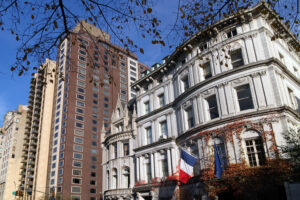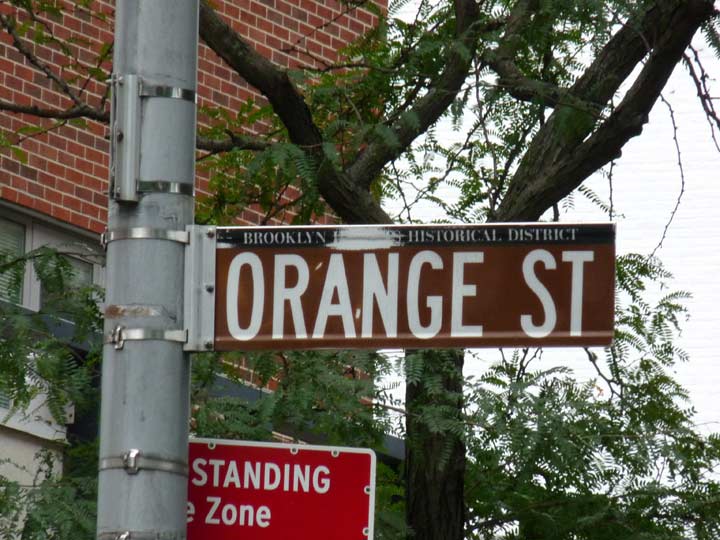
How did the Brooklyn Heights fruit streets get their unusual names? We can explain.
New Yorkers will be forgiven for wondering about the Brooklyn Heights fruit streets: Cranberry Street, Orange Street, and Pineapple Street, all tucked into this compact, historic brownstone neighborhood. How did the Brooklyn Heights fruit streets get these names, being miles from any orange orchards or pineapple fields? According to one story, a little old lady in tennis shoes is responsible for them — a century and a half before little old ladies started wearing tennis shoes.
How Did the Brooklyn Heights Fruit Streets Get Their Names?
Before the subway arrived in 1908, Brooklyn Heights was one of the borough’s more secluded areas; only the very wealthy could afford it. Jealousies and disputes arose among the moneyed gentry. The story goes, as recorded by the “WPA Guide to New York,” that in the decade prior to the Civil War, a local resident, whose name is given as Miss Middagh, resented her aristocratic neighbors, tore down the street signs bearing the names of the offending families, and hastily installed signs bearing the names of her favorite fruits and trees: Pineapple, Orange, Cranberry and Willow. When Brooklyn city authorities restored the original street names, Miss Middagh struck again and changed them back. This tug-of-war eventually resolved itself in the lady’s favor, with the streets retaining their plant names to this day.
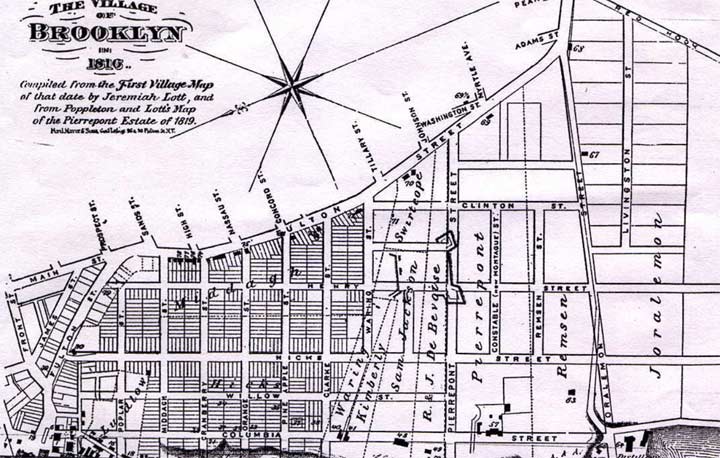
An 1816 map of Brooklyn Village compiled by Jeremiah Lott.
The Real History of Brooklyn Heights’ Fruit Streets
The more likely story, as told in Leonard Benardo and Jennifer Weiss’s indispensable guidebook “Brooklyn By Name,” is that they were simply named by early-19th century landowners the Hicks Brothers, John and Jacob. Each brother bore the middle name Middagh, their mother’s maiden name. There is a Middagh Street and, of course, a Hicks Street in Brooklyn Heights. An 1816 map of Brooklyn Village compiled by Jeremiah Lott, shown here, as well as William Hooker’s “Pocket Plan of 1827,” show the three streets in question as Pineapple, Orange and Cranberry. Though the tale of Miss Middagh is probably apocryphal, it does make for an amusing yarn.
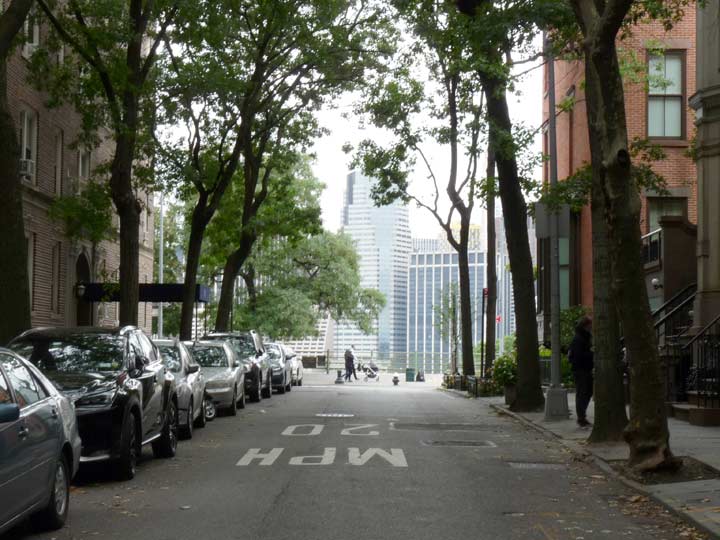
Cranberry Street looking west from Willow.
The three “fruit streets” are, for the most part, quiet, shady streets with brick or brownstone townhouses. Cranberry Street, in particular, offers an iconic view of downtown Manhattan at its western end. Walt Whitman briefly lived on Cranberry as a child, and “Leaves of Grass” was first printed in a now-demolished building at Fulton (now Cadman Plaza West) and Cranberry in 1855. The Cher film “Moonstruck” also had scenes filmed at 19 Cranberry St. at the corner of Willow.
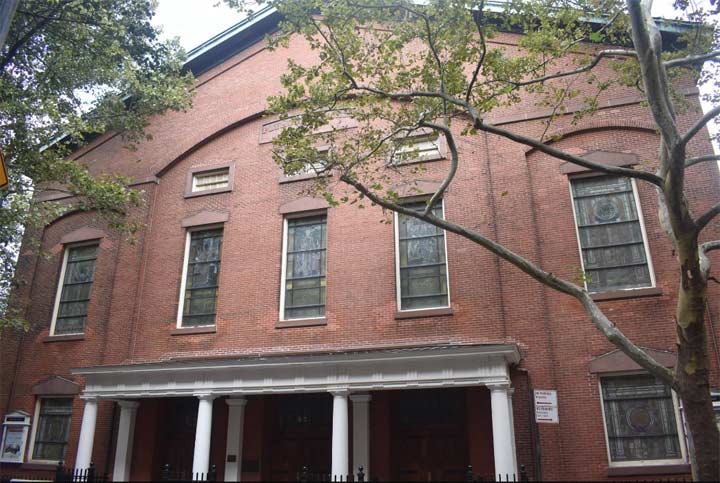
Plymouth Church. Photo: Robert Mulero
Plymouth Church on Orange Street in Brooklyn Heights
The corner of Orange and Hicks Street is dominated by the 1849 Plymouth Church of the Pilgrims, where Henry Ward Beecher preached from the church’s opening until 1887. Beecher, a lecturer and writer as well as a pastor, attained a preeminence almost equal to that of Abraham Lincoln at the height of the Civil War, and even endorsed products, which well-known ministers did in that era. The pastor staged mock slave auctions to call attention to the evils of slavery; his sister, Harriet, wrote the classic “Uncle Tom’s Cabin.” The church has been renovated in recent years and is worth a visit for services on Sundays.
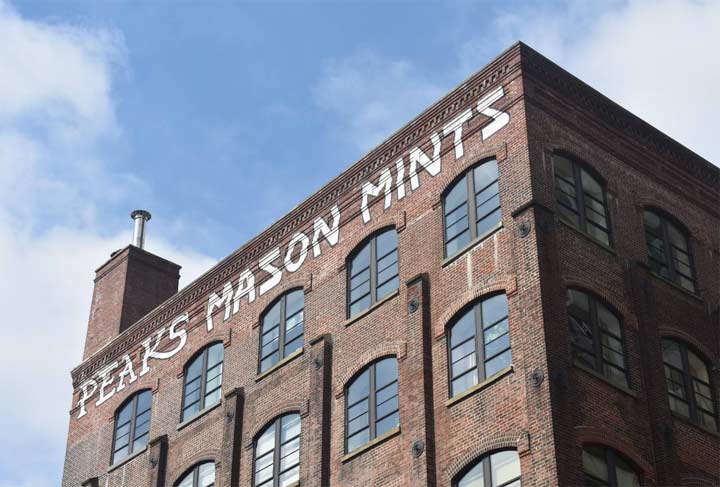
Photo: Robert Mulero
The Peaks Mason Mints Building in Brooklyn Heights
A very large painted ad on the corner of Henry and Middagh Streets proclaims Peaks Mason Mints, and is the former home of the Mason, Au and Magenheimer Candy Company. According to advertisement researcher Walter Grutchfield, the company was in business here between 1892 and 1949 and was founded by confectioners Joseph Mason and Ernest von Au in 1864.
In actuality the sign is a bit misleading, since there was no such candy as “Peaks Mason Mints”; there were Mason Peaks and Mason Mints. Mason Peaks were a coconut-chocolate combination (like Mounds) while Mason Mints were a chocolate-covered mint patty (like today’s York). Mason also made Dots, a fruit or cinnamon-flavored gumdrop, and Crows, a licorice-flavored gumdrop. Both are still distributed by Tootsie Roll, which acquired Mason in 1972.
Kevin Walsh is the webmaster of the award-winning website Forgotten NY, and the author of the books “Forgotten New York” and also, with the Greater Astoria Historical Society, “Forgotten Queens.”
—
Hey, why not like StreetEasy on Facebook and follow @streeteasy on Instagram?










